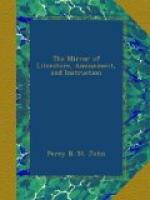“On a good level road I think it not improbable it might draw, instead of 7 tons which our experiment would give, from 10 to 11, besides its own weight, or 100 ordinary men, exclusive of 2 or 3 tons for carriages; and up one of our steepest hills, 3 tons besides itself, or 25 men besides a ton for a carriage. This it would do at a rate of 8, 9, or 10 miles an hour. For it is a singular feature in this carriage, and which was remarked by many at the time, that it maintained very nearly the same speed with a wagon and 27 men, that it did with the carriage and only 5 or 6 persons. But there is a fact connected with this machine still more extraordinary. For instance, every additional cwt. we shift on the hind or working wheels, will increase the power of traction in our steepest hills upwards of 4 cwt., and on the level road half a ton. Such, then, is the paradoxical nature of steam-carriages, that the very circumstance which in animal exertion would weaken and retard, will here multiply their strength and accelerate. This, no doubt, Mr. Gurney’s ingenuity will soon turn to profitable account.
“It has often been asserted that carriages of this sort could not go above 6 or 7 miles an hour. I can see no reasonable objection to 20. The following fact, decided before a large company in the barrack-yard, will best speak for itself:—At eighteen minutes after three I ascended the carriage with Mr. Gurney. After we had gone about half way round, ‘Now,’ said Mr. Gurney, ‘I will show you her speed.’ He did, and we completed seven turns round the outside of the road by twenty-eight minutes after three. If, therefore, as I was there assured, two and a half turns measured one mile, we went 2.8 miles in ten minutes; that is, at the rate of 16.8, or nearly 17 miles per hour. But as Mr. Gurney slackened its motion once or twice in the course of trial, to speak to some one, and did not go at an equal rate all the way round for fear of accident in the crowd, it is clear that sometimes we must have proceeded at the rate of upwards of twenty miles an hour.”
The Engraving will furnish the reader with a correct idea of such of Mr. Gurney’s improvements as are most interesting to the public. The present arrangement is certainly very preferable to placing the boiler and engine in immediate contact with the carriage, which is to convey goods and passengers. Men of science are still much divided on the practical economy of using steam instead of horses as a travelling agent; but we hope, like all great contemporaries they may whet and cultivate each other till the desired object is attained. One of them, a writer in the Atlas, observes, that “if ultimately found capable of being brought into public use, it would probably be most convenient and desirable that several locomotive engines should be employed on one line of road, in order that they might be exchanged at certain stages for the purposes of examination, tightening of screws, and other adjustments, which the jolting on passing over the road might render necessary, and for the supply of fuel and water.”




